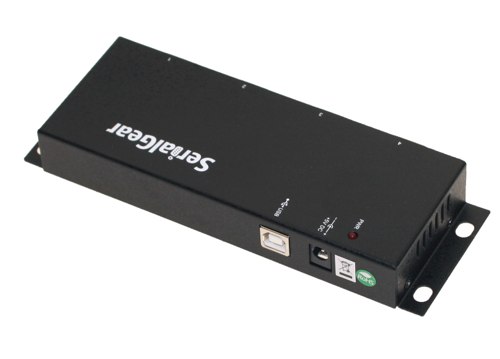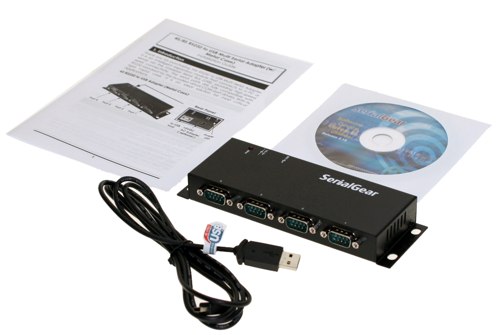Standards:
USB 2.0 Hubs
USB 3.0 (3.2 Gen 1) Hubs
USB 3.2 Gen 2 Hubs
USB Type-C Hubs
The USBG-BAY4 is a 4 port DB-9 RS232 to USB serial adapter that is designed for PC, thin client, or server. It provides instant communication port expansion when using the Universal Serial Bus (USB). The USBG-BAY4 has excellent scalability and quickly adapts to new USB technologies.
The USBG-BAY4 is a 4 port DB-9 RS232 Adapter to USB that is designed for PC, thin client, or server to provide 4 instant DB-9 RS-232 COM port expansions from the Universal Serial Bus (USB) host. This 4 port DB-9 RS232 Adapter provides the flexibility to quickly adapt to new USB technologies.
Multiple modules can be added to a single USB interface allowing you to add 1 to 4 serial RS232 port connections as needed helping your network grow with your requirements. With the USB Plug-and-Play features, you can simply plug in and follow the instructions of Install Wizard, You’re ready to use your serial devices once the installation is complete.

Going through a configuration with the Serial DB-9 RS-232 Adapter for Card Slots, I/O address, IRQ jumpers, DMA and others when you are connecting the devices is not necessary as the system will recognize the device and install the drivers automatically.

This product includes the following items:
Additional Features:
OS Support:
Form Factor:
*Surface Mounting screws not included.
| Compliance |
| ||||||||||
|---|---|---|---|---|---|---|---|---|---|---|---|
| Physical Characteristics |
| ||||||||||
| Serial Attributes |
| ||||||||||
| Software |
| ||||||||||
| Environmental |
| ||||||||||
| Hardware |
| ||||||||||
| Other Data |
|
The USB to RS232 4 port adapter has certain accessories that work with it. These accessories are what you can order if needed.
Model# 9DBMF5FT
$2.99In stock
View frequently asked product questions below. For all serial troubleshooting, visit this page.
Still need help? Reach out!
Test your components by:
When testing cables:
When testing serial ports and devices:
Note: You are required to restart your computer after disabling the Driver Signature Enforcement. Save all open work on your computer.
Disable driver signature enforcement:
When your system restarts:
When your computer restarts, Driver Signature Enforcement will be disabled and you can install the drivers.
Note: You are required to restart your computer after disabling the Driver Signature Enforcement. Save all open work on your computer.
Disable Driver Signature Enforcement:
After your computer restarts:
When your computer restarts, Driver Signature Enforcement will be disabled and you can install the drivers.
Once the driver/software is installed, follow these steps to allow the software:
George –
Great product at a great price.
Ralph –
We have used Serial Gear for over a dozen years and have always been satisfied with the quality, price and performance.
Customer –
This is not your cheap, plastic adapter. This is well built of metal and shielded with a good chip set. For that you have a fairly large piece of equipment that is larger and heavier than most other similar products.
It works as advertised and is RF proof for use in radio applications. I had no problems with my Windows 7 machine. Drivers worked with no problem and 4 comm ports were created in the OS.
You can use external DC power, but it will take power from the USB buss easily enough.
John B. Morris –
I have been using the SerialGear 4-port USB to RS-232 Serial adapter for about 9 months now. I use it for amateur radio applications where it is exposed to moderate levels of RF. It is well known that the FTDI chipset is superior to any other for radio control applications. The all metal enclosure properly shields the internal PCB from RF. I would recommend this to anyone needing a multi-port USB to Serial adapter, and especially to those working around RF. Brad, KA3YAN
Chris M –
Uses the FTDI 232RL chipset with support for the chipset’s full RS232 performance, 300bps to 921.6Kbps. Compatible with Linux, MacOS 8, MacOS 9, MacOS X, Windows XP, Windows Vista and Windows 7. Also, works with 64bit versions of the OSes listed that support 64bit. It worked in Linux with 2.6 to 3.x kernels and Windows 7 without the need to install drivers. Windows XP was able to download the drivers. Drivers are provided on the included CD and newer drivers are on their site. The device is small and works well.
This device is awesome, but I have two complaints.
1) The ports are close together so it is hard to use some connectors next to each other.
2) In Linux once a port was accessed, if I unplugged the device and connected it again, the ports that have been accessed can no longer be accessed. Ports that were not accessed previously can be accessed until the next unplug and replug. A restart fixes the issue. I imagine this is more related to the driver that my Linux OS was using and/or there may be a method that can allow access again without a restart that I have not found yet.